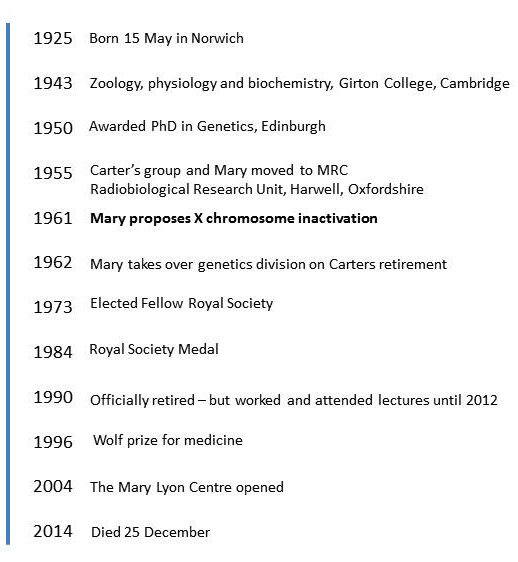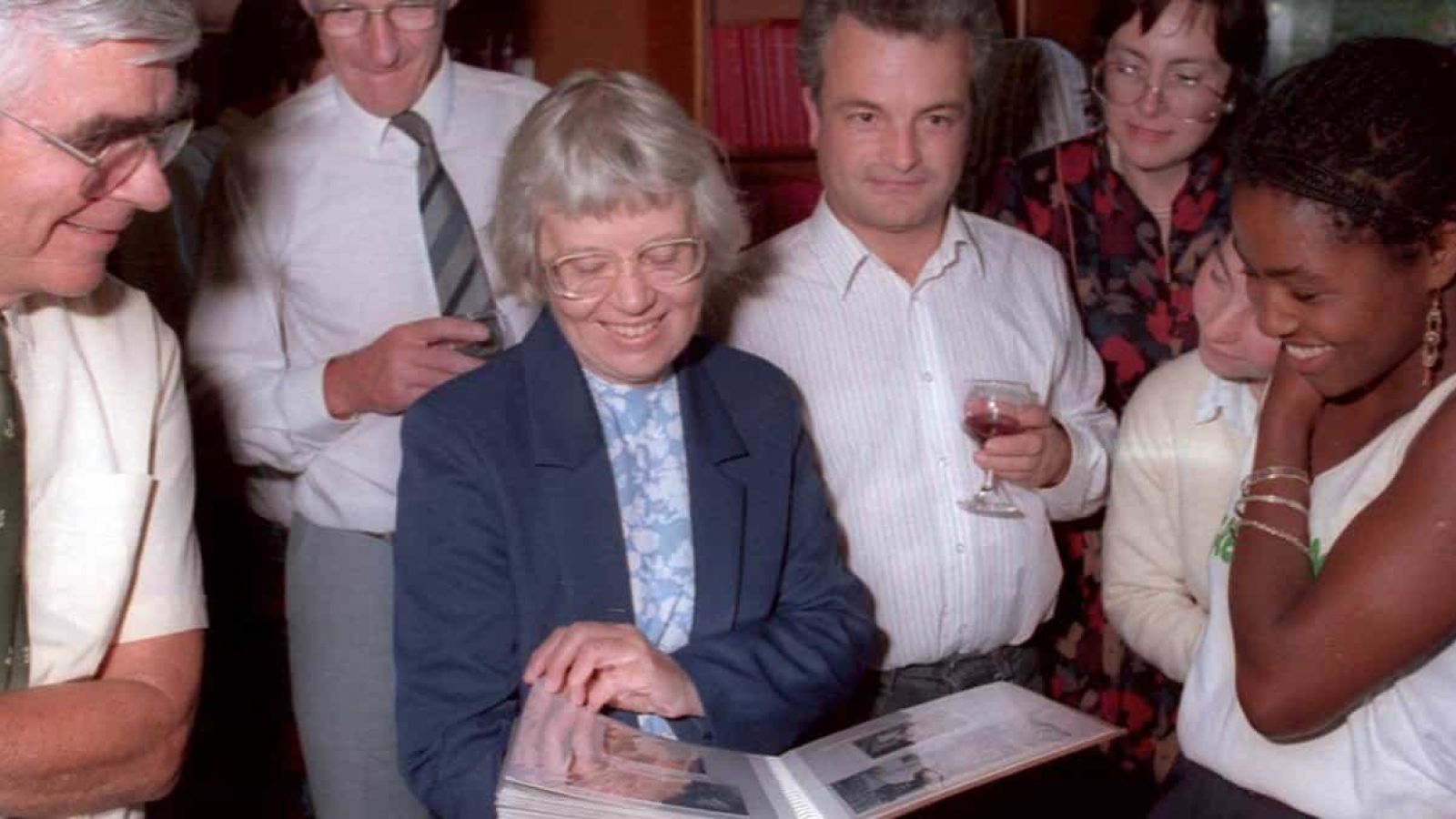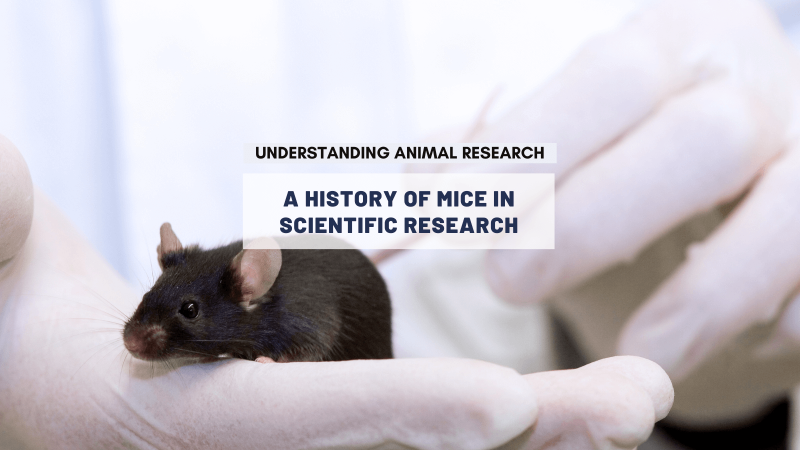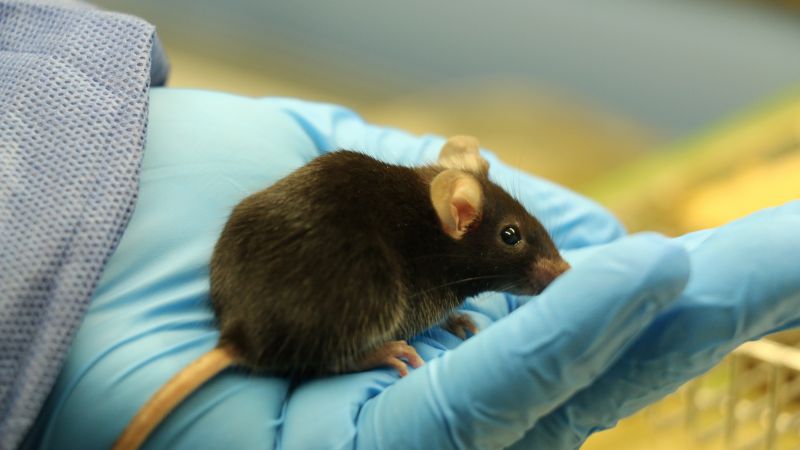A little south of Oxford is the Mary Lyon Centre*, an MRC funded research centre with perhaps the greatest variety of laboratory mice on the planet, especially if you count in the deep frozen mouse embryos kept in store there.

The unit is named after Mary Lyon, a scientist who spent much of her career in MRC Harwell. Mary died last Christmas, an event marked by obituaries in all the major papers. The articles all agreed on the key points in Mary's scientific career, but, perhaps not surprisingly, provided little detail on the first key discovery that made Mary famous - the process of X-chromosome inactivation, also known as lyonisation in her honour.
When you have grown up with a scientific education that accepts and assumes that only one in two of the pair of X-chromosomes in a mammal female is active, it is easy to be ignorant of how that knowledge first came about.
In the 1950's Mary was part of a team studying the impact of radiation. Mice were used as the model organism and some of these mice were descendants of mice caught in the vicinity of the atomic bomb explosions in Japan. They displayed different mutations, a range increased by exposing other mice to mutagens
In 1955 the research group Mary was in moved from Edinburgh to the MRC radiobiology unit in Harwell, where there was room for more mouse facilities.
Fairly soon after the move in 1955 Mary was working on a strain of mice with a peculiar inheritance pattern. This 'mottled' mouse had a mutation which had a different effect on male and female mice: male embryos sometimes died, any surviving males had white coats, but females lived and were variegated.
Through calculated and deliberated breeding of mutants, Mary investigated the transition of the mutation and concluded that the mutation was positioned on the X chromosome.
In 1959 Susumu Ohno showed that the two X-chromosomes of mammals were different: one appeared similar to the autosomes; the other was condensed and compact, visible under a light microscope.
In 1961, Mary Lyon proposed the random inactivation of one female X chromosome to explain the mottled phenotype of female mice heterozygous for coat colour genes. The Lyon hypothesis also accounted for the findings that one copy of the X chromosome in female cells was highly condensed, as reported by Sasumu Ohno.
Since then X-chromosome inactivation has become part of fundamental biological understanding. It explains why females with twice as many X chromosome as males do not have twice as many X chromosome gene products as males, who only possess a single copy of the X chromosome.
It helps explain why mutants with only one X chromosome are infertile females - and also how tortoiseshell cats get their colouration. Let us explore this example in a little more detail.
The choice of which X chromosome will be inactivated is random in placental mammals** but once an X chromosome is inactivated it will remain inactive throughout the lifetime of the cell and be inactivated in all its descendant cells in the organism.
Very early in development, in the blastocyst, the cells that give rise to the embryo randomly inactivate one copy of the X chromosome. This is irreversible so every descendent of those early cells will inherit the same pattern of inactivation.
 This phenomenon can be observed in the coloration of tortoiseshell cats when females are heterozygous for an X-linked gene, one form of the gene gives rise to black fur, one to orange fur. For any given patch of fur, the inactivation of an X chromosome that carries one gene results in the fur colour of the other, active gene.
This phenomenon can be observed in the coloration of tortoiseshell cats when females are heterozygous for an X-linked gene, one form of the gene gives rise to black fur, one to orange fur. For any given patch of fur, the inactivation of an X chromosome that carries one gene results in the fur colour of the other, active gene.
As the maternal and paternal X chromosomes have an equal probability of inactivation this would suggest that women with an inherited X-linked disorders such as haemophilia should suffer approximately 50% as often as men (because women have two X chromosomes, while men have only one); however, in actuality, the occurrence of these disorders in females is much lower than that.
The time period for X-chromosome inactivation explains this disparity. Inactivation occurs early in devlopment, but after cell division has started (in the epiblast during gastrulation, which gives rise to the embryo).Inactivation occurs on a cellular level, resulting in a mosaic expression, in which patches of cells have an inactive maternal X-chromosome, while other patches have an inactive paternal X-chromosome. For example, a female heterozygous for haemophilia (an X-linked disease) would have about half of her liver cells functioning properly, which is typically enough to ensure normal blood clotting.
Biological problems like this are relatively easily explained thanks to Mary Lyons insight, but her work did not end here.
Mary took over the genetics division in 1962 and remained its head until she retired 24 years later in 1990. She continued her academic work until 2012. During this time she worked on the t-complexand many other examples of gene expression and regulation and what we now call epigenetics.
 Mary was elected a Fellow of the Royal Society in 1973 and won numerous awards and honours during her career including the Royal Medal in 1984. The MRC Harwell Mary Lyon Centre opened in 2004 and in 2014 the UK Genetics Society created the Mary Lyon Medal in her honour.
Mary was elected a Fellow of the Royal Society in 1973 and won numerous awards and honours during her career including the Royal Medal in 1984. The MRC Harwell Mary Lyon Centre opened in 2004 and in 2014 the UK Genetics Society created the Mary Lyon Medal in her honour.
Sources
The Gift of Observation: An Interview with Mary Lyon
http://journals.plos.org/plosgenetics/article?id=10.1371/journal.pgen.1000813
http://en.wikipedia.org/wiki/X-inactivation
http://www.huffingtonpost.com/nessa-carey/mary-lyon_b_6439202.html
Images: MRC / wikipedia
Last edited: 28 October 2022 14:54




